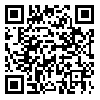Volume 10, Issue 3 (2021)
ORMR 2021, 10(3): 147-173 |
Back to browse issues page
Download citation:
BibTeX | RIS | EndNote | Medlars | ProCite | Reference Manager | RefWorks
Send citation to:



BibTeX | RIS | EndNote | Medlars | ProCite | Reference Manager | RefWorks
Send citation to:
Moradzadeh F, Hadavinejad M. A critical discourse analysis on civil disobedience in a public organization. ORMR 2021; 10 (3) :147-173
URL: http://ormr.modares.ac.ir/article-28-41280-en.html
URL: http://ormr.modares.ac.ir/article-28-41280-en.html
1- M. Sc., Department of Management, Faculty of Administrative Sciences and Economy, Vali-e-Asr University, Rafsanjan, Iran.
2- Associate professor, Department of Management, Faculty of Administrative Sciences and Economy, Vali-e-Asr University, Rafsanjan, Iran. , hadavi@vru.ac.ir
2- Associate professor, Department of Management, Faculty of Administrative Sciences and Economy, Vali-e-Asr University, Rafsanjan, Iran. , hadavi@vru.ac.ir
Abstract: (2491 Views)
The purpose of this study was to explore the attitudes about the civil disobedience in a public organization. The research strategy was critical discourse analysis and the participants were 20 employees of the mentioned organization who were selected through maximal variation and typical sampling methods. Data collection fulfilled with the use of the semi-structured interview tool until the theoretical saturation. Data analysis was based on Fairclough three-stage method (description, interpretation and explanation). The findings led to the discovery of three discourses of civil disobedience as taboo, natural, and necessary behavior. According to the taboo discourse, civil disobedience is informal and destructive behavior with disfunctional consequences for the organization and is therefore considered unauthorized. In natural discourse, civil disobedience is an algebraic mechanism inherent in the nature of the organization, so that when the current routine of the organization is unable to meet the members' demands for justice, a group of them will naturally engage in civil disobedience. In the essential discourse, civil disobedience is considered an acquired phenomenon by those members of the organization who have suffered psychological frustration and obstruction as a result of organizational injustice, and view it as the last resort and remedy for injustice in the organization.
Keywords: Disobedience, Civil Disobedience, Resistance to Change, Voice, Critical Discourse Analysis.
Article Type: Qualitative Research |
Subject:
Organizational Behavior and Human Resource Management
Received: 2020/03/8 | Accepted: 2020/09/28 | Published: 2021/01/13
Received: 2020/03/8 | Accepted: 2020/09/28 | Published: 2021/01/13
Send email to the article author
| Rights and permissions | |
 |
This work is licensed under a Creative Commons Attribution-NonCommercial 4.0 International License. |







